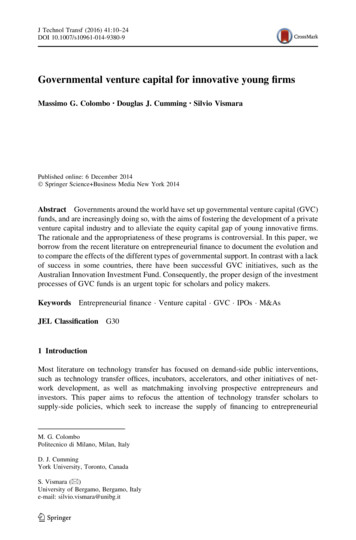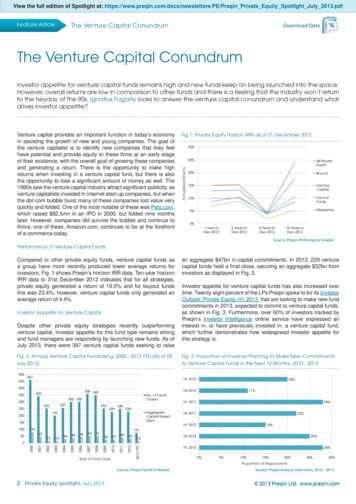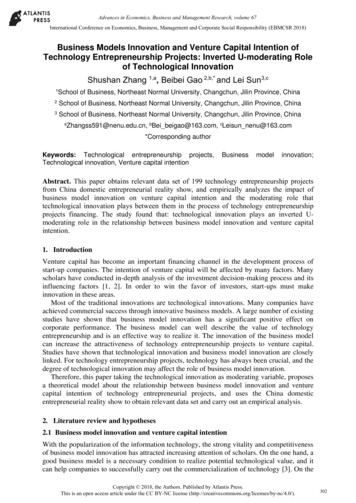
Transcription
J Technol Transf (2016) 41:10–24DOI 10.1007/s10961-014-9380-9Governmental venture capital for innovative young firmsMassimo G. Colombo Douglas J. Cumming Silvio VismaraPublished online: 6 December 2014Ó Springer Science Business Media New York 2014Abstract Governments around the world have set up governmental venture capital (GVC)funds, and are increasingly doing so, with the aims of fostering the development of a privateventure capital industry and to alleviate the equity capital gap of young innovative firms.The rationale and the appropriateness of these programs is controversial. In this paper, weborrow from the recent literature on entrepreneurial finance to document the evolution andto compare the effects of the different types of governmental support. In contrast with a lackof success in some countries, there have been successful GVC initiatives, such as theAustralian Innovation Investment Fund. Consequently, the proper design of the investmentprocesses of GVC funds is an urgent topic for scholars and policy makers.KeywordsEntrepreneurial finance Venture capital GVC IPOs M&AsJEL Classification G301 IntroductionMost literature on technology transfer has focused on demand-side public interventions,such as technology transfer offices, incubators, accelerators, and other initiatives of network development, as well as matchmaking involving prospective entrepreneurs andinvestors. This paper aims to refocus the attention of technology transfer scholars tosupply-side policies, which seek to increase the supply of financing to entrepreneurialM. G. ColomboPolitecnico di Milano, Milan, ItalyD. J. CummingYork University, Toronto, CanadaS. Vismara (&)University of Bergamo, Bergamo, Italye-mail: silvio.vismara@unibg.it123
Governmental venture capital11ventures (Meoli et al. 2013). In particular, this paper highlights the role of GVC funds. Inso doing, we aim to inform the broader public about the impact of public policy towardsVenture Capital (VC) and, hopefully, to provide policy makers with an international andcomparative perspective on the effects of the governments’ efforts, which may guide futureinterventions. First, we review the prior research on this topic and provide a picture ofGVC programs around the world. Then, we identify some open research questions andenlarge the scope to encompass the role of public policies in developing VC markets andfostering access to public equity markets.Innovative young firms play a key role in modern knowledge-based economies, as theyare an important source of new jobs, radical innovations, and productivity growth, as wellas a tool for disciplining established firms (Audretsch 1995; for up-to-date evidence relatedto 18 countries, see Criscuolo et al. 2014). Unfortunately, these firms suffer from financingconstraints, which limit their growth and menace their survival. Lack of internal cash flowand collateral, asymmetric information, and agency problems are the main reasons for theirdifficulties in raising external capital (Carpenter and Petersen 2002). Given the importanceof innovative young firms and of external financing for these firms, the crucial role playedby VCs in fostering entrepreneurship is evident and has been documented by numerousstudies (e.g. Colombo and Grilli 2010; Chemmanur et al. 2011; Puri and Zarutskie 2012;Croce et al. 2013). VCs provide portfolio companies with bundles of value-added activities, including direct coaching and indirect benefits, such as a certification effect to thirdparties (e.g. customers, skilled workers, alliance partners, and financial intermediaries)(Gompers and Lerner 2001).However, for reasons that will be discussed in detail in next section, the equity gapfaced by young innovative firms cannot be entirely solved by the private VC market. Inresponse, many governments have set up programs to foster VC financing, through theestablishment of GVC funds (Cumming et al. 2009). Besides addressing the financial gapproblem, GVCs can pursue investments that will ultimately yield social payoffs andpositive externalities for society as a whole. The drawback of these instruments, however,is that they may crowd out rather than stimulate private investments. The rationale andappropriateness of these programs are at the center of a controversial academic debate,which we review in this paper.Currently, VC markets in many countries exhibit a dearth of capital, with negativeeffects on innovative young firms (Cumming 2014). Assessing the impact of public policyon VC markets seems particularly important in this climate. Indeed, the recent financialcrisis has increased the difficulty for these firms to raise seed and early-stage finance, asVCs have become more risk adverse and have focused on later-stage investments (Blockand Sandner 2009). As a consequence, policy interventions have increased in recent yearsin many OECD countries (Wilson and Silva 2013).2 Rationale for governmental venture capitalThe creation of GVC funds is primarily meant to correct for supply-side failures indomestic VC markets.1 Due to the information asymmetries surrounding young innovative1VC investors are typically classified on the basis of their ownership and governance structures. Anindependent VC is a limited partnership in which a management company raises capital from limitedpartners, often institutional investors. VC forms other than independent VCs are collectively known ascaptive VCs, which include corporate VCs (affiliated with a nonfinancial corporation), bank-controlled VCs123
12M. G. Colombo et al.firms, it is likely that adverse selection, moral hazard, and agency problems may lead to amarket failure for entrepreneurial finance.2 This financing gap is alleviated by VCs, whoaddress informational asymmetries by intensively scrutinizing firms before providingcapital and monitoring them afterwards (Hall and Lerner 2010). Nonetheless, in anunderdeveloped seed and early-stage market, direct governmental intervention can behelpful for filling the firms’ equity capital gap. Private investors do not easily acquire theskill set needed to be good VCs. Government programs can facilitate the training of goodVCs. Moreover, government awards to private parties certify the quality of the company,help the company become established, and enable the company to secure other sources offunds (as well as suppliers, customers, etc.) (Lerner 1999). The selective provision of GVCfunds to underfunded young innovative firms can signal their high potential to privatesector investors and, thus, foster the additional funding of these firms. Thanks to signalingeffects, GVCs can have a positive, crowding-in effect on the development of VC markets.As GVC is generally instrumental to broader policy objectives, the activity of GVCprograms is not guided exclusively by the financial goals that are (allegedly) typical ofprivate sector investors. Accordingly, during the selection process, GVCs will considerinvestments that might not be as satisfactory in terms of return for risk, if the investmentcould generate significant social payoffs or localized public benefits (e.g. job creation oreconomic growth in a specific region or sector). Investment opportunities in underprivileged regions, for instance, could remain unpursued without governmental intervention.GVC programs may be able to alleviate some problems in peripheral and economicallylagging regions lacking an indigenous VC industry.Thus far, we have provided a justification for a public engagement in VC programs.However, intervention is valuable only when its benefits outweigh the costs of its implementation. While action to address the market failures is theoretically justified, it might becounterproductive. With reference to GVC activity, there are three main concerns. First,there is skepticism regarding the ability of GVC investors to pick winners, becauseinvestors might lack the skills to perform successful selections or because of possibledistortions of the investment strategies due to political interests (Brander et al. 2008).Second, GVC programs might not be effective in monitoring, nurturing, and mentoringinvestee companies (Cumming et al. 2014). Third, and most importantly, public investmentmay displace private investment, leading to crowding-out effects (Armour and Cumming2006; Cumming and MacIntosh 2006). As GVC investors have broader objectives thanindependent VCs, they are less accountable for generating high returns. Therefore, theprovision of cheap equity capital by GVC investors discourages private investors, leadingto replacement, rather than engagement, of private VCs.Footnote 1 continued(affiliated with a bank), and governmental VCs (the focus of this paper). For an extended discussion of therationale for the creation of GVC programs, see, e.g. Cumming and Johan (2013). Similar to GVC programs,in guarantee systems, the government commits to covering, totally or partially, potential losses of privateVC funds, so a minimum return to private investors is warranted.2It is widely accepted that entrepreneurial ventures are a major source of innovation, employment, andgrowth. Market failures are related to the public good nature of innovation, which causes free-riding andinsufficient incentives for investments, as well as to information asymmetries, which generate adverseselection and moral hazard problems.123
Governmental venture capital133 Definition and taxonomy of GVC fundsGovernments may have various intentions and objectives when setting up GVC programs.To the extent that these objectives differ, there will be heterogeneity in the types of firmsthat the GVCs invest, in the effort that they devote to their investee firms, and, ultimately,in the efficacy of their investments. The success of a GVC program also depends on theinstitutional environment in which it operates, which is typically poor in lagging areas(Florida and Kenney 1988). For example, the mission of the UK Regional Venture CapitalFund is ‘‘to ensure that each region [in England] has access to at least one viableregionally-based venture capital fund making equity-based investments in smalleramounts’’.3 All else being equal, this affects more the performance of GVCs aimed primarily at regional development and localized job creation than those that more broadlypoint to support the development of a young high-tech industry or to seed private sectorinvestors. Therefore, the effectiveness of GVC programs largely depends on their designand aims.Different definitions of GVC are available in the literature, ranging from a narrowerfocus on VC funds managed by governmental bodies, to broader classifications that includetaxation policies aimed at favoring the engagement of private investors. With regard todirect public intervention, there is heterogeneity in the type of allocation of governmentalfunds to GVCs. Allocation types can be classified into three categories: direct public funds,hybrid private–public funds, and funds-of-funds. To be as comprehensive as possible, wecomprehend and compare the effects among all types of governmentally supported funds.Direct public funds include investments through government-supported VC-likeschemes, often with the aim of facilitating the development of a VC industry within aregion or industry. For example, In-Q-Tel was founded by the US Federal IntelligenceCommunity in 1999 to finance information technologies. OnPoint Technologies wasfounded by the US Army in 2002 to finance investments for new power and energysolutions. Due to problems related to a lack of skills or crowding-out issues, some of theseprograms have been modified to include coinvestments from private investors. The German High-Tech Gründerfonds fund, whose investors include the German Federal Ministryof Economics and Technology, the KfW Banking Group, and 12 industrial groups, is anexample of a hybrid VC fund. From a critical perspective, these public–private partnerships could be viewed as subsidies to large firms. Lastly, government support can take theform of funds-of-funds, which invest in other investment funds rather than investingdirectly in companies. On January 21, 2014, the Canadian Finance Minister announced theestablishment of the Northleaf Venture Catalyst Fund, the first fund-of-funds establishedunder Canada’s Venture Capital Action Plan. Of the CAN 217.5 million in this fund,CAN 145 million are from institutional and corporate investors, while the governments ofCanada and Ontario each provide CAN 36.3 million.4 Empirical evidence from around the worldIn this section, we first present evidence on the systemic effects of GVCs, and then focuson the effects on their portfolio firms. Systemic effects basically refer to the effects thatGVC programs have on the development of a private VC industry. GVC funds might3‘‘Addressing the SME Equity Gap: Support for Regional Venture Capital Funds’’, URN 99/876. Small andMedium Enterprise Policy Directorate, DTI, Sheffield.123
123European Venture CapitalAssociationEuropean VC data, 1990–2003Canadian VC Data, 1990–2004550 New-Technology Based Firms inItalyAustralian VC data, 1982–2005European VC data, 1990–2012Canadian VC Data, 1990–2004Australian VC data, 1982–2005Armour andCumming(2006)Brander et al.(2008)Colombo et al.(2007)Cumming (2007)Cumming (2011,2014)Cumming andJohan (2008)Cumming andJohan (2009)Thompson SDCCanadian Venture CapitalAssociationEuropean Venture CapitalAssociationThompson SDCCanadian Venture CapitalAssociationVenture Economics andZephyrBelgium VC data, 1998–2007Alperovych et al.(2013)Data sourceSample descriptionAuthorsTable 1 Summary of selected studies on governmental venture capitalAustralian government subsidized Pre-Seed Investment Funds (PSFs)facilitated the development of the Austalian VC industry, and are more likelythan private funds to invest in early stage companies. PSFs have smallerportfolios per manager (implying more advice per manager). There are largedifferences in performance across the different fund managers awardedlicences PSFs to operate PSFsGovernment subsidized labour sponsored sponsored venture capital funds inCanada more often have inefficient exits in terms of more frequent secondarysales and buybacks. To some extent there is evidence that governmentsubsidized labour sponsored sponsored venture capital funds are also morelikely to have write-offsWhether or not European government VC funds have not crowded out privateventure capital investments depends on benchmarking and measurement.Comparison of aggregated data based on VC/GDP, VC/Population, and earlystage VC/late stage VCAustralian government subsidized Innivation Investment Funds (IIFs)facilitated the development of the Austalian VC industry, and are more likelythan private funds to invest in early stage high technology companies. IIFsalso syndicate and stage more often, and have smaller portfolios per manager(implying more advice per manager)The presence of inefficiencies in venture capital markets are not alleviated bythe existing Italian technology policy measures towards high-tech start-upsCanadian subsidized labour sponsored venture capital funds in Canada are lesslikely to finance companies that develop patents, implying less value-addedby investorsEuropean government VC funds have crowded out private venture capitalinvestments. Aggregated data based on VC/GDPThe presence of a public investor in the equity of Belgian entrepreneurial firmstranslates into statistically significant reductions in the relative growth ratesand relative performance with respect to their privately-backed peersSummary of findings14M. G. Colombo et al.
Australian Private Equityand Venture CapitalAssociationCanadian Venture CapitalAssociationGlobefunds.comVICO DatasetVICO DatasetAustralian VC data, 1990–2012Canadian VC data, 1977–2001Canadian LSVCC data, 2000–2005European private and government VCinvestments, 1990–2010European private and government VCinvestments, 1990–2010Not applicableCumming andJohan (2014b)Cumming andMacIntosh(2006)Cumming andMacIntosh(2007)Cumming et al.(2014)Grilli andMurtinu(2014a)Jääskeläinenet al. (2007)Johan et al.(2014)Leleux andSurlemont(2003)Removal of a tax subsidy in one province (not others) led to the reduction inprivate entreprise investment and increase in investment in publicly tradedcompanies by 58 %Globefunds, and annualreportsEuropean Venture CapitalAssociationCanadian government subsidized laboursponsored venture capital corporations1995–2011European VC Data, 1990–1996Large public participation is correlated with smaller VC industries, butanalyses do not support the view that public venture capitalists are acting toseed the industry or that are they crowd-out private fundsThe authors compare the incentive effects of different profit distributionschemes for different private and public investors fund structuresGovernment VC deals syndicated with private VCs do better in terms offinancial performanceGovernment VC deals with private syndicated VCs do better in terms of exitoutcomesCanadian Labour Sponsored Venture Capital Funds underperform peers, andcharge higher fees than their peers. Fees are unrelated to performanceCanadian Labour Sponsored Venture Capital Funds crowd-out private venturecapital fundsAustralian government subsidized funds have facilitated employment, R&D,patents, time to IPO, and market capitalization relative to private VC fundsand non-VC backed companiesCanadian government subsidized labour sponsored venture capital funds arequicker to exit investments that go public, and have a smaller proportion ofIPOs, than private venture capital investments in Canada, as well ascompared to U.S. venture capital investments, implying less value added preIPOSummary of findingsNot applicableThompson SDCCanadian and U.S. venture capital data,1990–2004Cumming andJohan (2010)Data sourceSample descriptionAuthorsTable 1 continuedGovernmental venture capital15123
Not applicableNot applicableNot applicable; survey of articles in abookNot applicableLerner (2012)Keuschnigg andNielsen (2001,2003)Thompson SDCUS SBIRLerner (1999)Data sourceSample descriptionAuthorsTable 1 continued123The authors derive, from theoretical models, conditions under which tax policytowards venture capital and entrepreneurship promotes efficient outcomesand improvements in social welfareGovernment venture capital funds typically under-perform in most countriesaround the worldSBIR awards certify quality of early stage ventures and facilitate growthSummary of findings16M. G. Colombo et al.
Governmental venture capital17contribute to expand the market and attract private, independent investors, or mightactually substitute for private VCs. This stream of literature has direct implications on localdevelopment and has been studied from different perspectives, including regional economics. At a firm level, studies focus on the selection and treatment effects that couldpossibly arise from GVC programs. This research stream has yielded useful insights intoentrepreneurial finance and entrepreneurship in general. These two types of studies (i.e.systemic vs. firm level) typically use different aims and methodologies. Therefore, wepresent them in two separate sections. Table 1 summarizes the sample, data sources, andcontributions of most of these studies in alphabetical order.4.1 Effects of GVC at the systemic level: crowding in versus crowding outThe role of GVC is not limited to the benefits yielded to investee firms, as their outreachencompasses the economy at large. First, these programs typically seek a crowding-ineffect on private VCs. For instance, the Australian Innovation Investment Fund (IIF) aims‘‘to develop a self-sustaining Australian early stage, technology-based venture capitalindustry’’ (Cumming and Johan 2013). By seeding the private VC market, GVCs aim tocorrect or alleviate market failures in entrepreneurial finance, thereby promoting competition and a more entrepreneurial economy. ‘‘Fostering entrepreneurship’’ is one of themost frequent cited objectives of GVCs, as new enterprises supported by GVCs areexpected to provide additional competition in the marketplace.Existing studies on GVC have pointed to both successful and unsuccessful experiencesof GVC programs in different countries. In terms of the former, in 1958, the US Congresscreated the Small Business Investment Company (SBIC) scheme, which has subsequentlyserved as a benchmark program worldwide. In this model, government involvement, eitherdirect or indirect, enables additional capital to be raised, thereby creating a leverageadvantage for private investors. In Israel, the Yozma Group was launched in 1993 usingpublic funds. Yozma is widely considered to be the catalyst for the successful developmentof the domestic VC industry in that country. As the domestic VC industry matured, the roleof the government declined, and Yozma was privatized and sold.Similarly, governmental support, particularly the IIF program, has been very helpful inAustralia. Prior to 1998, there were few early-stage venture investments in Australia.Establishment of the IIF program in 1997 led to more investments in subsequent years,even after the collapse of the Internet bubble (Cumming 2007). Brander et al. (2014) findthat markets with more GVC funding have more VC funding per enterprise and more VCfunded enterprises, suggesting that GVC finance largely augments, rather than displaces,private VC finance. Further evidence of crowding-in effects comes from Hood (2000), whoshowed that the Scottish public VC program SDF was followed by the formation of newprivate VC funds.In contrast, Armour and Cumming (2006) find no support for the crowding-in effect in asample of 15 Western European and North American countries. Bertoni et al. (2014) showthat although European governments have tried to fill the seed investment gap left byprivate VC investors, by launching GVC funds (e.g. university seed and regional government-controlled funds) and investing in small, young, seed-stage companies, notablybiotech firms,4 they have failed to attract private VCs to these companies. In Quebec,4This study is based on the VICO database of young high-tech entrepreneurial companies operating inseven European countries (Belgium, Finland, France, Germany, Italy, Spain, and the UK). The datasetconsists of 8,370 companies, 759 of which are VC-backed, and 1,125 VC investors.123
18M. G. Colombo et al.Canada, Labour-Sponsored Venture Capital Corporations (LSVCCs) were established in1983 and extended to other Canadian provinces from 1988 to 1993. However, LSVCCssuffer from crowding-out problems (Cumming and MacIntosh 2006, 2007) and werephased out of Ontario. Since 2011, the government in this province has adopted a modelakin to the Australian model.4.2 Effects of GVC at firm level: selection and treatmentBesides the crowding-in effects on the private VC industry and systemic effects on theeconomy, the desired achievements of GVC funds include direct returns from the companies in which they invest. A growing literature has examined the treatment effect(Bertoni et al. 2011, 2013) of GVC investments in portfolio firms. We review this literatureby considering different performance measures: namely, successful exit, innovation, andgrowth. We also consider evidence related to coaching and the value added by GVCinvestors to portfolio firms.4.2.1 ExitOne clear-cut measure of the performance of VCs is their ability to exit successfully fromtheir investments. In a European study, Cumming et al. (2014) find a positive contributionof independent VCs on the likelihood to reach an exit though IPO or M&A, whereas GVCshave a negligible impact. However, mixed independent-governmental syndicated VCinvestments lead to a higher likelihood of a positive exit than independent VC-backedinvestments. Cumming and Johan (2014) show that Australian IIF backing results in ahigher percentage of investments that are publicly listed, as well as a greater marketcapitalization of such investments relative to both VC- and Private Equity-backed firms.Croce and Ughetto (2014) find no significant impact of the switching dynamic from anindependent to governmental VC (or vice versa) on the probability of successful exit.Other studies find less positive effects of GVC. In Canada, GVC-backed companies areless likely to be sold as IPOs and acquisitions, whereas they are more likely to be sold assecondary sales and buybacks (Cumming and Johan 2008). GVCs (e.g. LSVCCs) are morelikely to exit sooner than would otherwise be optimal for the investee (Cumming and Johan2009, 2010). Moreover, Johan et al. (2014) find that as a result of the elimination of taxcredits and the removal of certain investment restrictions, Ontario’s LSVCCs have driftedfrom their original mandate towards investing in less risky listed companies. In a Europebased study, Buzzacchi et al. (2013) find that while independent VCs divest low-returninvestments as soon as possible, GVCs tend to postpone the exit from those ventures thatmight generate social returns or exert positive impacts on the economic system, even iftheir financial returns might not be satisfactory.4.2.2 InnovationYoung innovative firms play a central role in spurring innovation and are a vehicle fortransferring and capitalizing knowledge (Audretsch et al. 2008). For these reasons, they areoften the target of policy support. Audretsch et al. (2002) find that the US Small BusinessInvestment Research program has been effective in stimulating R&D, and that its net socialbenefits have been substantial. Similarly, because private investors are unlikely to ensurethe full appropriation of returns of R&D investments, GVCs can be helpful in facilitating123
Governmental venture capital19innovation. A specifically stated goal of GVC programs is to promote innovation. Forexample, the Australian IIF aims to encourage private sector investment in R&D activities.The German Mittelständische Beteiligungsgesellschaften aims to assist in the commercialization of R&D activities, building linkages between research agencies, the financecommunity, and business. Other GVC programs seek to foster the development of specifictechnologies and sectors identified as being strategic to the nation or region. In Israel,Yozma invested in companies in the fields of Communications, IT, and MedicalTechnologies.Finally, GVC fund managers have more positive attitudes toward academic entrepreneurship. Knockaert et al. (2010) find that the likelihood of a VC fund being open toinvesting in academic spin-offs is positively affected by the percentage of public funding ina VC fund. Nevertheless, Murray (1998) suggests that commercial funds are more likelythan regional public funds to lead to innovation. Using a sample of European biotech andpharmaceutical entrepreneurial ventures, Bertoni and Tykvova (2012) find that firmsbacked by independent VCs outperform those backed by GVCs in terms of patentingactivity. However, the best results are obtained when independent VCs join forces withGVCs4.2.3 GrowthA few studies have focused their attention on the effects of GVC on growth. For example,firms backed by independent VCs generally outperform those backed by GVCs, in terms ofgrowth rates of sales or total assets. Using data from the VICO database relating to a multiEuropean country context, Grilli and Murtinu (2014a) find that GVC investment has nosignificant effect on the sales growth of portfolio firms. There is some evidence of a salesimpact when funding is syndicated, although the governmental investor is subordinate tothe private interest. Grilli and Murtinu (2014b) also show that the negligible impact of thesole GVC investments is independent of the age of the investees. They corroborate theview that cofinancing between public and private operators is effective only when theytarget the youngest prospects. Alperovych et al. (2013) find that, for VC-backed firms,public backing translates into statistically and economically significant reductions ofefficiency. Vanacker et al. (2014) find that firms backed by a corporate, government, oruniversity VC investor are less likely to raise additional equity financing compared to firmsbacked by independent VC investors.The goal of GVCs often explicitly includes job creation and job empowerment. As themost common measure of local economic performance (Audretsch 2002), employmentgrowth is connected to regional development. Young innovative firms grow so rapidly intheir early years that the jobs they create offset job losses from early-stage businessfailures. By facilitating their creation and growth, GVCs aim to contribute indirectly toemployment. However, this treatment effect of GVCs on employment growth is negligible.Empirical evidence comes from studies in European countries (Grilli and Murtinu 2014a),Australia (Cumming and Johan 2014), and Spain (Balboa et al. 2007). Whereas Balboaet al. (2007) show that private VCs have a positive impact, Grilli and Murtinu (2014a) findno significant effect, even for independent VCs and syndicated investments.4.2.4 Value added and coachingThe studies reviewed above generally suggest that GVC backing has a dismal treatmenteffect on the performance of firms, with the possible exception of privately led mixed123
20M. G. Colombo et al.governmental-private syndicates. The underperformance of GVC-backed firms may be dueto their lower engagement in coaching and value-adding activities for their portfolio firms.Knockaert et al. (2006) and Knockaert and Vanacker (2013) show that the managers ofcaptive funds are less involved in value-adding activities than independent VCs. Coherently, Schäfer and Schilder (2006) report that GVC funds have more portfolio firms permanager. Further reasons for underperformance include excessive capital under management relative to the number of managers (Cumming and MacIntosh 2007), lack of controland ability to effect changes in inve
Published online: 6 December 2014 . OnPoint Technologies was founded by the US Army in 2002 to finance investments for new power and energy solutions. Due to problems related to a lack of skills or crowding-out issues, some of these . of Economics and Technology, the KfW Banking Group, and 12 industrial groups, is an example of a hybrid VC .











